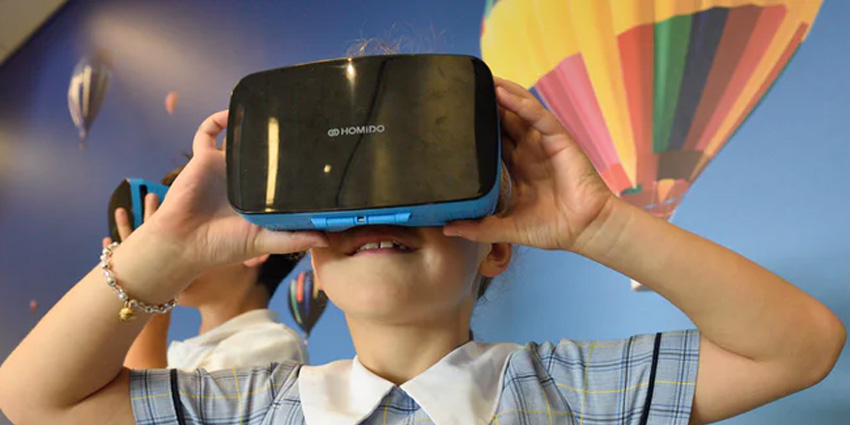Of all the possible changes extended reality (XR) tech can bring to the world, its impact on education is one of the most exciting.
Every day humans are getting smarter. The way millennials and Gen Z absorb information is drastically different from the generations before them. This is set to change in 50 years now.
With the arrival of XR tech in the education space, people can already see what the future has in store for tomorrow’s students.
According to research, the VR education market will hit $200 million by the end of 2020 and $700 million by 2025. Currently, it is the 4th biggest vertical for VR investments as the features and benefits this technology brings to education are seemingly limitless.
Immersive Limitless Learning
Many teachers and professionals working in education state the most difficult aspect of their job is that it is difficult to keep kids engaged.
A Udemy poll found that 74 percent of Millennials and Gen Z said they were easily distracted in the workplace. People share information much more quickly and easily than in recent decades.
Educators must remain knowledgeable of how to keep today’s students engaged in the classroom. Embracing emerging technologies such as XR can help bridge the gap between generations.
Rather than following traditional whiteboard lecture styles of instruction, VR offers a fully immersive learning experience where students can thrive. With immersive learning, education becomes an experience that is fun, relevant, and engaging.
Immersive classroom providers GigXR offer a fantastic platform for engaging with real-time 3D content. Students can take notes on immersive content, learn human anatomy and medicine, and collaborate with other students and instructors.
The platform features RT3D holograms from ANIMA RES, providing hyperrealistic visuals for learners to engage with. This significantly boosts engagement and retention among learners young and mature.
Enhances Teacher Creativity & Job Satisfaction
Most learners that struggle with acquiring their targets and goals can later suffer from stress as a result. This can impact long-term performance and motivation as they lose interest in classes due to difficulties with subject material. Some students may need hands-on, experiential learning methods over lecturing and reading to internalise their courses.
With VR, however, teachers can explore new and exciting immersive learning platforms that appeal to the modern generation. They can also create new lesson plans in virtual environments and provide fun, interactive learning experiences for their students.
Companies such as Gamooz gamify reading books for children, significantly boosting engagement levels with 2D pop-up content, and offering more publishers and authors access to the technology for their books. This costs them much less than more widely-used gaming engines such as Unity or Unreal Engine.
Conversely, enterprise users employ major educational platforms such as ENGAGE XR and Arthur VR for their needs. These virtual spaces facilitate large-scale meetings, presentations and speeches, as well as testing for instructors, streamlining the educational process.
Improves Student Performance & Results
XR learning has also been proven to enhance the performance and results of the students who use it.
In a recent study, it was found that over 80 percent of people using AR devices experienced increased learning motivation and 93 percent said it increased their spatial understanding of subjects.
According to reports, many learners now have this option with immersive learning. Studies show that learners receive on average 75 percent retention rates with XR. This is compared to reading and lectures at 10 percent and 5 percent, respectively.
Educators use AR to help children with learning difficulties overcome their struggles in the classroom.
Augmenta11y uses AR to help children with dyslexia read books using the camera on their phone, and as the market grows we can expect to see many other developers exploring this space.
Reduced Educational Costs
While XR tech may seem like a sizeable short-term investment from schools, long-term benefits are staggering. Educational institutions spend substantial money on traditional learning tools like lab equipment, books, learning tools, and others. The expenses accumulate quickly, and people must replace and repair teaching materials each term.
Virtual learning environments make physical materials redundant. Students in immersive classrooms can save their notes, classes, presentations, and experiences to the cloud. They can also access them when needed, without lost notes or forgotten homework.
Teachers can take students on regular field trips to museums, aquariums, destinations, and others without ever leaving the classroom. This saves schools thousands on travel and admission costs.
Companies like Accenture and Varjo have detailed the massive cost-saving benefits of using XR. The former company created its Metaverse Continuum, which outlines how businesses can leverage VR and AR for their businesses. Accenture collaborated with Meta Platforms after it bought 60,000 headsets to onboard new hires of the massive enterprise.
The latter, the world’s most advanced headset manufacturer, saves companies massive costs with deployable, on-demand training for military and commercial pilots.
The Future of XR in Education?
As technology continues to evolve and the XR market continues to grow, we can expect to see some huge innovations opening up in this space that could change the world forever. XR tech will play a vital role in reshaping education to solve problems that schools, teachers, and students face.







